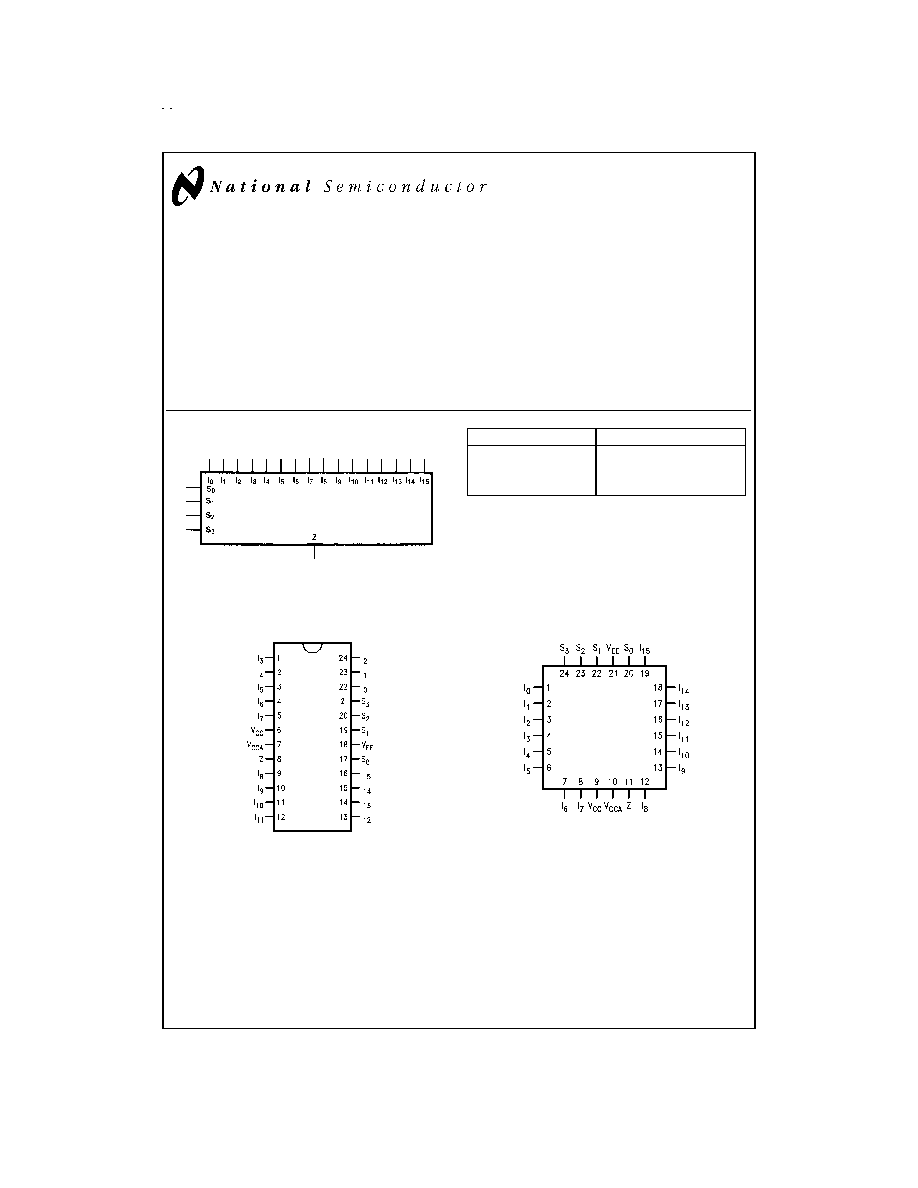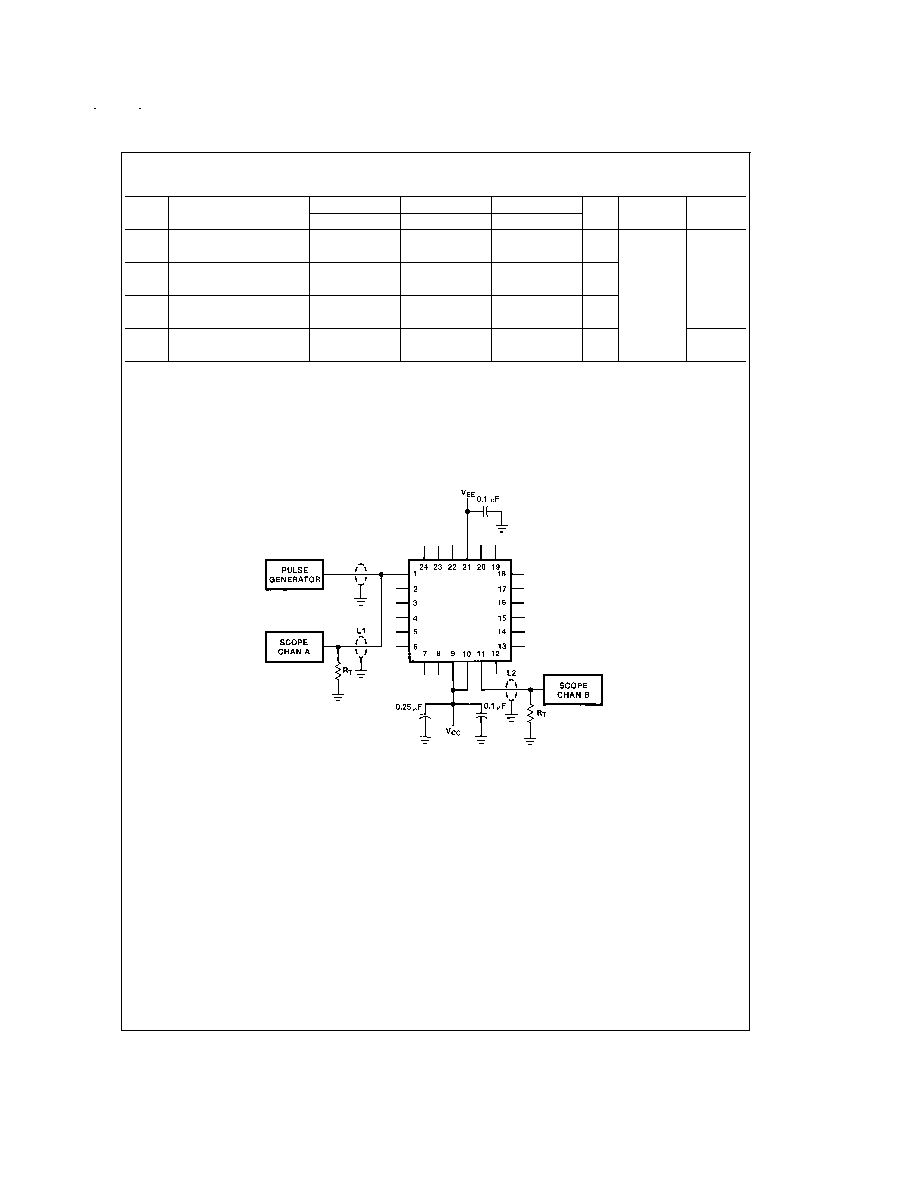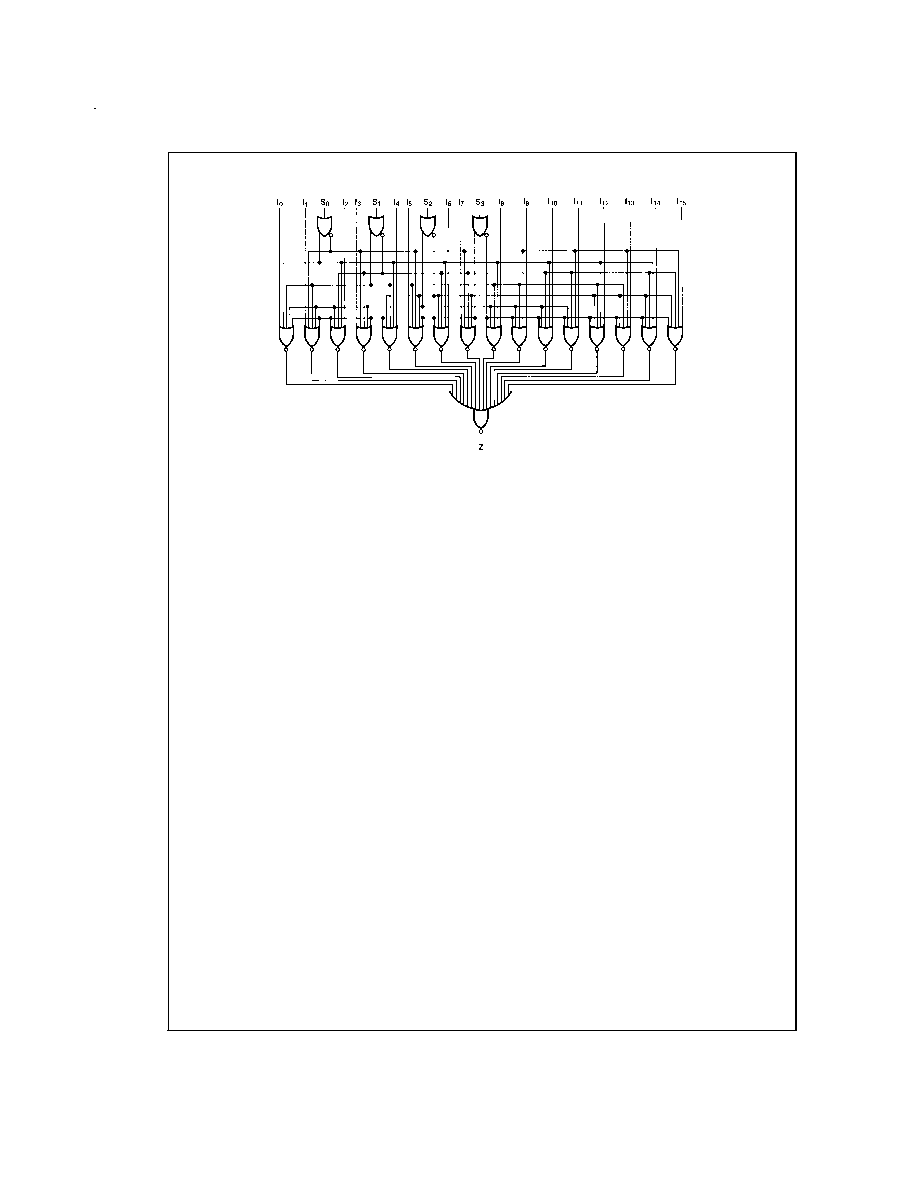
100364
Low Power 16-Input Multiplexer
General Description
The 100364 is a 16-input multiplexer. Data paths are con-
trolled by four Select lines (S
0
≠S
3
). Their decoding is shown
in the truth table. Output data polarity is the same as the se-
leted input data. All inputs have 50 k
pulldown resistors.
Features
n
35% power reduction of the 100164
n
2000V ESD protection
n
Pin/function compatible with 100164
n
Voltage compensated operating range = -4.2V to -5.7V
n
Available to industrial grade temperature range
n
Standard Microcircuit Drawing
(SMD) 5962-9459201
Logic Symbol
Pin Names
Description
I
0
≠I
15
Data Inputs
S
0
≠S
3
Select Inputs
Z
Data Output
Connection Diagrams
DS100301-1
24-Pin DIP
DS100301-2
24-Pin Quad Cerpak
DS100301-3
August 1998
100364
Low
Power
16-Input
Multiplexer
© 1998 National Semiconductor Corporation
DS100301
www.national.com

Absolute Maximum Ratings
(Note 1)
If Military/Aerospace specified devices are required,
please contact the National Semiconductor Sales Office/
Distributors for availability and specifications.
Above which the useful life may be impaired
Storage Temperature (T
STG
)
-65∞C to +150∞C
Maximum Junction Temperature (T
J
)
Ceramic
+175∞C
Pin Potential to
Ground Pin (V
EE
)
-7.0V to +0.5V
Input Voltage (DC)
V
EE
to +0.5V
Output Current
(DC Output HIGH)
-50 mA
ESD (Note 2)
2000V
Recommended Operating
Conditions
Case Temperature (T
C
)
Military
-55∞C to +125∞C
Supply Voltage (V
EE
)
-5.7V to -4.2V
Note 1: Absolute maximum ratings are those values beyond which the de-
vice may be damaged or have its useful life impaired. Functional operation
under these conditions is not implied.
Note 2: ESD testing conforms to MIL-STD-883, Method 3015.
Military Version
DC Electrical Characteristics
V
EE
= -4.2V to -5.7V, V
CC
= V
CCA
= GND, T
C
= -55∞C to +125∞C
Symbol
Parameter
Min
Max
Units
T
C
Conditions
Notes
V
OH
Output HIGH Voltage
-1025
-870
mV
0∞C to
V
IN
= V
IH
(Max)
Loading with
(Notes 3, 4,
5)
+125∞C
or V
IL
(Min)
50
to -2.0V
-1085
-870
mV
-55∞C
V
OL
Output LOW Voltage
-1830
-1620
mV
0∞C to
+125∞C
-1830
-1555
mV
-55∞C
V
OHC
Output HIGH Voltage
-1035
mV
0∞C to
V
IN
= V
IH
(Min)
Loading with
(Notes 3, 4,
5)
+125∞C
or V
IL
(Max)
50
to -2.0V
-1085
mV
-55∞C
V
OLC
Output LOW Voltage
-1610
mV
0∞C to
+125∞C
-1555
mV
-55∞C
V
IH
Input HIGH Voltage
-1165
-870
mV
-55∞C to
Guaranteed HIGH Signal
(Notes 3, 4,
5, 6)
+125∞C
for All Inputs
V
IL
Input LOW Voltage
-1830
-1475
mV
-55∞C to
Guaranteed LOW Signal
(Notes 3, 4,
5, 6)
+125∞C
for All Inputs
I
IL
Input LOW Current
0.50
µA
-55∞C to
V
EE
= -4.2V
(Notes 3, 4,
5)
+125∞C
V
IN
= V
IL
(Min)
I
IH
Input HIGH Current
300
µA
0∞C to
V
EE
= -5.7V
(Notes 3, 4,
5)
+125∞C
V
IN
= V
IH
(Max)
450
µA
-55∞C
I
EE
Power Supply Current
-95
-35
mA
-55∞C to
Inputs Open
(Notes 3, 4,
5)
+125∞C
Note 3: F100K 300 Series cold temperature testing is performed by temperature soaking (to guarantee junction temperature equals -55∞C), then testing immediately
without allowing for the junction temperature to stabilize due to heat dissipation after power-up. This provides "cold start" specs which can be considered a worst case
condition at cold temperatures.
Note 4: Screen tested 100% on each device at -55∞C, +25∞C, and +125∞C, Subgroups, 1, 2, 3, 7 and 8.
Note 5: Sampled tested (Method 5005, Table I) on each manufactured lot at -55∞C, +25∞C, and +125∞C, Subgroups A1, 2, 3, 7 and 8.
Note 6: Guaranteed by applying specified input condition and testing V
OH
/V
OL
.
www.national.com
4

AC Electrical Characteristics
V
EE
= -4.2V to -5.7V, V
CC
= V
CCA
= GND
Symbol
Parameter
T
C
= -55∞C
T
C
= 25∞C
T
C
= +125∞C
Units
Conditions
Notes
Min
Max
Min
Max
Min
Max
t
PLH
Propagation Delay
0.50
2.60
0.60
2.40
0.60
2.80
ns
Figures 1,
2
(Notes 7,
8, 9)
t
PHL
I
0
≠I
15
to Output
t
PLH
Propagation Delay
0.70
3.30
0.90
3.10
1.00
3.50
ns
t
PHL
S
0
, S
1
to Output
t
PLH
Propagation Delay
0.50
2.90
0.70
2.60
0.60
3.00
ns
t
PHL
S
2
, S
3
to Output
t
TLH
Transition Time
0.20
1.20
0.20
1.20
0.20
1.20
ns
(Note 10)
t
THL
20% to 80%, 80% to 20%
Note 7: F100K 300 Series cold temperature testing is performed by temperature soaking (to guarantee junction temperature equals -55∞C), then testing immediately
without allowing for the junction temperature to stabilize due to heat dissipation after power-up. This provides "cold start" specs which can be considered a worst case
condition at cold temperatures.
Note 8: Screen tested 100% on each device at +25∞C, temperature only, Subgroup A9.
Note 9: Sample tested (Method 5005, Table I) on each Mfg. lot at +25∞C, Subgroup A9, and at +125∞C, and -55∞C temp., Subgroups A10 and A11.
Note 10: Not tested at +25∞C, +125∞C and -55∞C temperature (design characterization data).
Test Circuit
DS100301-6
FIGURE 1. AC Test Circuit
www.national.com
5




